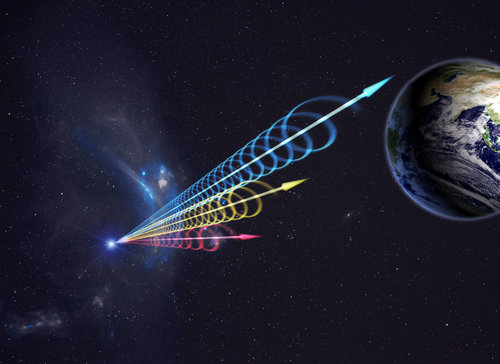An international team of researchers including Dr. Yichao Li and Prof. Xuelei Chen from NAOC discovered a new Fast Radio Burst (FRB) which has been named FRB 110523. This discovery is published on the December 2nd 2015 issue of Nature.
FRBs are short and bright radio outbursts in the distant Universe. Since its first discovery in 2007, only a few more than ten were found, and mostly from the data recorded by the Parkes telescope in Australia. The origin, burst mechanism, and even location are still being debated, and it is one of the hot topics of current astronomical research. The international team with members from the USA, Canada, Chinese Mainland and Taiwan, and South Africa have been using the Green Bank Telescope of the USA to make surveys of neutral hydrogen, and have collected 650 hours of observing data. The FRB110523 is discovered by re-analysis of its data archive, and it is the first FRB discovered with GBT.
Compared with previously discovered FRBs, the present discovery data provides more information, especially it has a complete record of the polarization of the FRB, linear polarization is clearly detected. Through the analysis of the linear polarization, a strong Faraday rotation effect is discovered, this shows that the burst may have occurred in a highly magnetized region, possibly a recent supernovae remnant or star-forming nebular. The dispersion of the FRB have a spectral index of 1.998, very close to the value produced by rarefied plasma (2) and excludes dense plasma such as those found in star flares. The FRB data also exhibits scintillation and scattering. The NAOC researchers conducted analysis of these data, compared its scintillation with the pulsar J2139+00 which is located only 2 degrees away on the sky, and found that the scintillation is similar to that pulsar, showing that the scintillation is caused by the interstellar medium of the Milky Way. On the other hand, the scattering must have happened near the FRB. For the scintillation in Milky Way to happen, the apparent angular size of the FRB must be very small, this place a limit of about 1 Gpc on the FRB. These observations have excluded some models of FRB, and greatly narrow its possible location and origin, thus providing important clues for the FRB.
The Tianlaiarray which is being built by NAOC will also conduct neutral hydrogen surveys. With some slight revision and improvement, the Tianlai array can also be used to search for FRB while conducting its survey, said Prof. Xuelei Chen. With more discovered events and more data interpreted, astronomers will eventually solve the puzzle of FRB.
The NAOC researchers who participated in this discovery and the construction of the Tianlai array are supported by the MOST 863 program and the CAS Strategic Priority Research Program.














